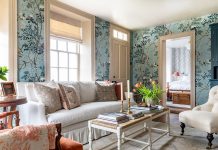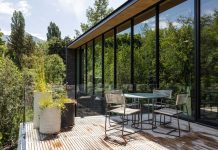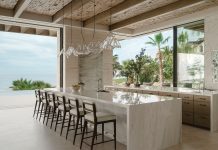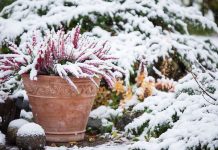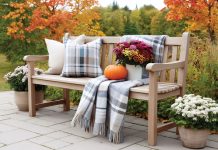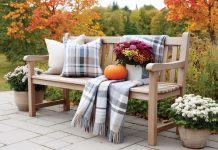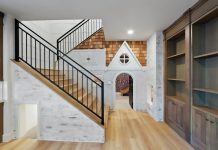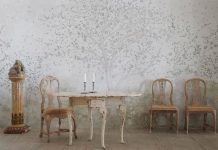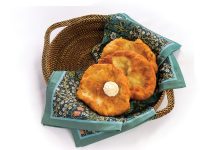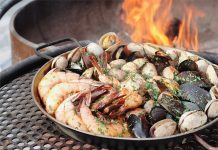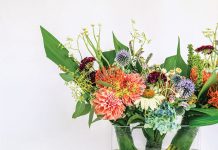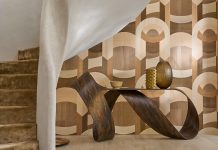Mexico’s historic haciendas and splendid gardens inspire artists of all kinds. Count floral designers Sarah Winward and Nicole Land among them. Traveling from their homes in Salt Lake City, these pros teamed to host a collaborative flower workshop at the luxury retreat Hacienda Acamilpa, a 17th century sugar mill nestled in the Mexican countryside south of Mexico City. “It’s an incredible setting surrounded by nature, which is integral to both of our work,” Winward says. Land agrees. “We are inspired by how things grow in nature and take our cue from our surroundings.”

There were plenty of cues to go around. From the Hacienda’s stately Colonial architecture and romantic spaces to its vine-covered porticos and glorious grounds, the retreat served as an oasis of inspiration for Winward and Land as they instructed floral designers from around the globe.

For two magical days, the Utah designers composed stunning arrangements and floral displays, explaining the thoughts and techniques behind their creations. Here, Winward and Land share a number of the concepts they discussed during the workshop to help you craft memorable arrangements of your own.

Draw from Your Surroundings
“Whether you’re cutting from your garden or pulling from a Mexican jungle, take your cues from nature,” Land says. Also consider your site to create compositions that are extensions of the surroundings, Winward suggests. The duo walked Hacienda Acamilpa’s grounds for ideas and inspiration, and they became enchanted by jungle overtaking stone walls and blooming vines covering archways. “It was so lush and layered, and that fueled our designs,” Winward explains. Assisted by Mexican florists By Allegra, the duo sourced local flowers and plants from Mexico City, providing a curated mix of materials for arrangements.

Choreograph Color
“We are inspired by subtle and nuanced shades of green, blue and brown in our work, but there are a lot of contrasting colors like hot pink, yellow and orange that grow naturally in Mexico,” Winward says. The duo selected many muted elements like curly dried ferns and brown lisianthus to balance the more vibrant indigenous flowers and foliage they selected. To begin each arrangement, the designers created a monochromatic base palette by using tones close to each other on the color wheel, and then they “punched in” contrasting colors repeated throughout the composition. “The colors look cohesive but not loud,” Land explains.


Touch on Texture
“Texture makes an arrangement more interesting,” says Winward, who chooses blooms of different sizes and shapes to create the desired texture. “Unlike a vase of roses that just gets stuck, we use big blooms lower in an arrangement and then layer on the lighter and smaller shapes just as you would add pillows to a sofa to create interest,” she explains.

Take Shape
While teaching the ins and outs of centerpiece design, the duo began with footed compotes created by local potter CAT Ceramic. Then they composed uniquely shaped arrangements that capture the natural aesthetic that defines their work. Flowers and foliage rise and fall with peaks, valleys and rivers formed by colors and shapes. “You want to create continuous paths for the eyes,” Lands explains. Asymmetrical yet balanced, the compositions sit low with branches spilling over the sides, just as they would from a garden shrub. Meanwhile, assorted blooms intermingle congenially. Dahlias, for example, may face forward in a more assertive stance while delicate pansies turn sideways to the sun or bow their heads in a loose, retired pose. Beneath, scatterings of berries or dropped petals may extend the arrangement onto the tabletop, finishing the compositions. Winward explains, “The arrangements are meant to be experienced, not just seen.”

Contain Your Enthusiasm
Vessel strategies from Winward and Land

Urns
Large urns are ideal for “creating impactful moments with towering oversized arrangements,” says Winward, who often uses them to adorn entry tables, kitchen islands and event bars. Unlike smaller centerpieces, urn compositions are looser and less detail oriented. “It’s about stepping back and letting the product do the work for you,” says Land. She often bunches and repeats a single material like apple branches to deliver the drama. “The impact is the abundance and scale, rather than the variety of materials,” says Land, who combined an overflowing volume of foxglove, lisianthus and fern to fill this large terra-cotta urn.

Compotes
“Compotes help elevate the design and allow the flowers to float above the table,” says Winward, describing the footed bowls. Their arrangements’ success relies on a curated mix of materials and an attention to detail when integrating them. The raised vessels also allow the designs to spread beyond the containers by placing fruit, petals or small blooms on the table top surface below. “With small arrangements, it’s all about the details,” says Land, who loosely mingled tulips, ranunculus, pansies, straw flower, clover and wandering vines in this compote arrangement. Tiny red potatoes scatter below.


All photos by Heather Nan
Read more articles from our garden series here!


